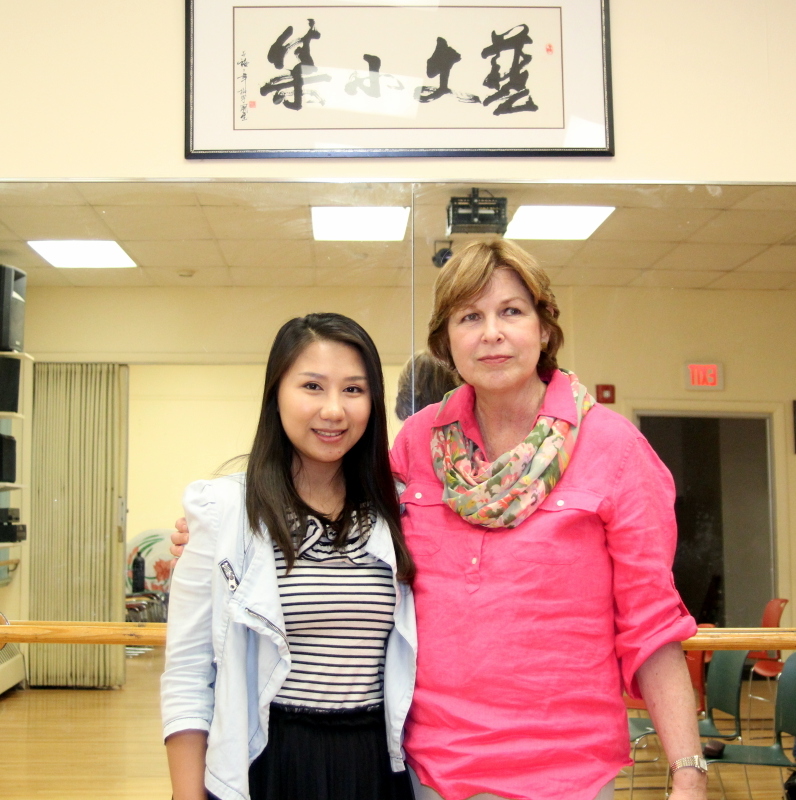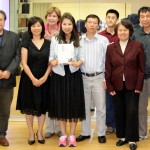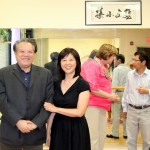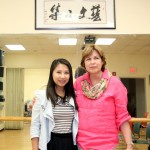(Note: Ms. Taylor delivered this speech about her new book Red Thread at the Yiwen Club in Nowton, Mass. on June 7, 2015)
By Virginia Ross Taylor
Thank you, Zeyang, for inviting me, and thanks to all of you for coming today to hear about The Red Thread, or Hong Si Xian. I am especially grateful to Harry Chen, whose essential roles in this book process have included translator and agent. The families of Zeyang Wang and Harry Chen have been very important to my family for more than a decade.

Ms. Taylor (right) and Xiaoyang Chen, president of Yiwen Club, pose for a picture(photos provided to bostonese.com).
But let me start from the beginning of this story. About 20 years ago, my husband Bill and I went through the elaborate process of applying to adopt a baby from China. Finally, the time we were permitted to travel arrived, and we flew to Hong Kong and then on to Hangzhou. The day we got there we received a phone call in our hotel overlooking the West Lake.
“Come to the lobby; your baby is here,” our guide said cheerily. As the elevator opened onto the lobby, eleven eager middle-aged parents stepped off to meet our children for the first time. After this momentous drama, with a circle of observers standing all around, Bill and I were ushered to the offices of the Zhejiang Province Bureau of Civil Affairs across the street, where we promised that we would raise our beautiful new daughter to know and value the culture of her birth country. Four years later Bill and I made the same promise to officials in Jiangxi Province: we will help our second new baby grow up knowing about the culture of the land of her birth.
Easy to say when you’re more than 7,000 miles from home! But how exactly do adoptive Caucasian parents keep this promise?
We were so fortunate that a Chinese school in Acton opened its doors.
We were welcomed to the Acton Chinese Language School from its very beginnings. Founders Harry Chen and Zeyang Wang reached out even during the planning stages to the community of families in Acton and surrounding towns who had adopted children from China. At the time we had a network of adoptive families, and we met to celebrate CNY and the Autumn Moon festival, but we knew little of REAL Chinese culture.
After being invited to be part of ACLS, more than 20 children adopted from China registered for the first language classes. Several months later it became obvious that the Chinese children of American parents weren’t learning as fast as those who spoke Chinese at home and whose parents could help them. Our children fell behind and began inventing all sorts of excuses for missing Chinese class.
ACLS responded by launching a separate track of classes for children learning Chinese as a second language.
I first came t the Chinese school to honor a promise—a promise that 25 years ago I never dreamed I’d be making. At that time I was an English professor working in Atlanta. I had friends of different ethnicities, but my world was focused on events and people in the U.S. When Bill and I applied to adopt a child from China, we might not have been aware of it, but we were opening a door—not only to parenthood—but one that would lead down pathways to many unexpected places.
As promised, we tried through the years to expose our daughters to Chinese people and Chinese culture. The feeling that we had a responsibility to help our children learn about China came partly by listening to young women adopted from Korea. Adopted Koreans are the largest group of people adopted from any single country; since the Korean War, more than 140,000 Korean children have been adopted by Americans. Generally, Korean babies were escorted by caregivers to the US. Most of the families never traveled to Korea. During the 1960s and 70s, when these children were growing up, parents were advised they should help their children assimilate: they should try to make the child as American as possible rather than celebrating his Korean heritage. As adults many of these young men and women say sadly that part of their identity was lost for a very long time.
Part of honoring our children’s Chinese heritage was a trip back to China again in 2010, so that Anna and Catherine, 16 and 12 at the time, could see the splendid sights of their birth country—the history of Beijing, the dazzling skyscrapers of Shanghai—as well as the orphanages and towns where their spent their first months, and in my younger daughter’s case, her first year and a half.
Two things on that trip, beyond the fabulous scenery, were striking to me.
1. Questions from friendly, curious strangers: “Why are you with these Chinese children?” they asked. And when we said we were their adoptive parents, they had more questions: “What are their lives like in the US? Do you treat them as you would your own biological children? What do they think of China?” Obviously, the people who were asking questions did not realize that it’s not uncommon for Americans to adopt children from China.
2. The other experience that impressed me was the way the girls were welcomed at their orphanages.
As we rode down a bumpy road in Jiangxi, Shangrao, I heard popping noises and then realized they were firecrackers. About 20 people had assembled on the steps of the Shangrao Social Welfare Institute, and a big banner was displayed over the building’s front gate: It read Huan ying Xiao Chun hui jia.
Two days later we were in Zhejiang, Jiande, speaking with the director of my older daughter’s orphanage. Suddenly a woman walked in whom I recognized, and whom even Anna recognized from her baby pictures. This was the woman who had handed her to me 18 years before. She no longer works in the adoption field and she has moved to Hangzhou, about three hours away. But she came back that day to see Anna again, and the connection was powerful.
Watching the reaction of these people and also watching the ayis take care of the babies currently in their care, I was so aware of how important is the work that they do. Studies show that the less time a baby is treated impersonally as a ward in an institution, the better the outcome for their personal, social, and intellectual development. In hot, un-air-conditioned rooms, these nannies were making it possible for the babies to develop an early human connection, and making who knows what difference in these children’s futures.
When we came back from this trip and I talked to my friends about these orphanage visits, Harry’s wife June Chang said to me, “Why don’t you write a book about this?”
So I did. The book is intended for a Chinese audience. It attempts to answer the questions that friendly strangers asked me on the streets of Beijing and Shanghai, Chengdu and Nanjing. Why did we adopt children from China? Why do so many Americans adopt there? What is life like for the children growing up in America? How about when they reach adolescence? How do they feel about the birth parents who gave them up and about the country where they were born?
I found it frustrating not to be able to communicate with the people who took care of my children in their infancy. You can’t quite get the same kind of connection when you speak through an interpreter. So I wanted those people to see this book, to read it, and to see their own pictures on the pages, to see the pictures of the girls growing up, and mostly to recognize that American parents understand how valuable their work is.
Let me tell you about the title: The Red Thread, or Hongsixian.
There is an old Chinese legend that says, “The gods tie an invisible red thread to each baby’s ankle, connecting it to those who are destined to be important in his life. The thread may stretch or tangle but will never break.”
The legend of the red thread expresses through an image better than I can express in words a sense of destiny that many adoptive parents feel.
After going through the long process of applying to adopt a baby from China—from endless paperwork, recommendations from family and friends, signatures from employers and for my husband all the way up to the Secretary of State, being fingerprinted by the police department and interviewed on four occasions by a social worker, we were finally approved to adopt. Then came a long wait while our documents, which filled a folder the size of an encyclopedia, were translated into Chinese and sent to Department One at the Chinese Center of Adoption Affairs. After that, we heard, they would be sent to Department Two, where dossiers or folders from prospective adoptive parents would be matched with folders of babies available to adopt. A few months after our documents had been sent, I began to check the mail every day to see if we had word from China. Then one day a few days after Christmas, I was distracted and opened the mailbox looking for bills and bank statements. There was a package of documents all the way from Beijing. I couldn’t read the Chinese characters on the envelope or in the enclosures, but the tiny photograph spoke to my heart. I looked into the dark brown eyes of the baby who was to become my child. A continent and an ocean stood between me and this baby, but already I felt a force pulling her to me.
The legend of the red thread embodies a deep emotional truth. Sometimes when we look at our children, we marvel at our fortune. The smallest change—a delay in paperwork, a dossier moved to a different stack, a decision to undergo one more round of infertility treatment—could have changed everything. We would have missed being joined by the red thread connecting us with the children who were meant to be ours.
Four years later, after another long wait to adopt a second baby, we received another large packet in the mail from Beijing. Again, I felt the pull of connection the moment I saw her face in the photograph.
This sense of connection that we felt after seeing our daughters’ pictures for the first time is shared by other adoptive families. We all felt we became parents the moment we saw the babies’ photographs and signed the agreement to adopt them. After wanting a child for a long time, to be matched with a particular child is an extremely powerful experience. I believe that others may not recognize that is the moment this deep attachment begins. During both our adoption trips to China, officials trying to be helpful suggested to a family in our travel group that a healthy child replace their already matched child who was obviously ill. “No,” the parents objected loudly in each case. “The child in the photograph is my child!”
When you adopt a child who is a different ethnicity than you, you draw stares. I thought I, as a tall redhead, drew curious looks in Hong Kong, but that was nothing compared to the attention our party received as we walked through Hangzhou: eleven Americans who among us had six Chinese babies in carriers on our backs. Most of the looks were approving: “Hen piao liang,” said several onlookers. I smiled and nodded in agreement.
When we came back to the US, we also drew stares on the streets, in restaurants, in airports. People would look from one of us to the other, obviously trying to figure out the relationship. This was much more true when we brought our older daughter Anna home than when we adopted Catherine four years later. By then it was almost commonplace to see Caucasian families with Chinese babies. And by 2014, more than 80,000 Chinese babies had been adopted by Americans and are growing up in America. It seems that everyone knows someone who has a child from China. As we walked through a shopping mall, another Caucasian adult with a Chinese child in tow sometimes approached us, “My daughter is from Wuhan; how about yours?” Especially during our early years as a family, these meetings turned into long discussions.
When Anna and Catherine first saw us in those hotel lobbies in Zhejiang and Jiangxi Provinces, we must have looked and sounded very strange and foreign—tall white people speaking in a toneless language. Over time, however, Bill and I became the faces and voices they were accustomed to. They got used to seeing us as their parents, as part of the natural order of things. Gradually, inevitably, they became aware of the ethnic difference. They began to notice questions, often several a week, from strangers in the grocery store. Most of the questioners observed our interactions and assumed we were a family, but not one formed in the customary way. “Where is your daughter from?” I was often asked. The girls also came to realize that most families to do not elicit these types of questions. “Why do people always have to ask about our family” Anna complained. The curious looks and questions annoyed the girls even more as they became adolescents. I was so eager to share happy stories that I didn’t recognize at first how embarrassed the girls would become when they had to stand in the middle of a store listening to tales of our adoptions from China. At that point, what they most wanted was to be like everyone else and to fit in.
And where do they fit in? With other Chinese children in the town? Or with Caucasian children? This is a difficult question that I try to address in the book. Although my children have been fortunate that their high school has a high percentage of Asian students, they have sometimes suffered from the expectations placed on Chinese young people in this area. I’m sure that adopted Chinese children are not the only ones who feel tyrannized by these stereotypes. I remember one day Anna came running home from the bus stop in tears, upset that a classmate had seen her grade of B- on an algebra test. “How can you get a B-?”,the boy exclaimed. “You’re Chinese!” Learning about the history of Chinese immigration in her junior high school social studies class helped Anna understand that not all the Chinese people living in America have had the same experience as our town’s Chinese citizens, many of whom rose to the top of their schools in China and earned prestigious American fellowships and jobs. Learning about these patterns of immigration, she understood that she, too, is part of particular wave of immigration—over a period of 15 years, she is one of 80,000 babies who automatically became U.S. citizens.
Just as we were fortunate that there was a Chinese school in Acton when our daughters were old enough to take classes, we were also excited to be part of a committee encouraging the high school to offer instruction in Mandarin. How can you call a department World Languages, we said, if it teaches the languages of only a small corner of Western Europe? Anna was able to register to take Chinese in in her freshman year. The years of instruction in writing characters at ACLS helped her do well. Now, a rising college senior, she’s minoring in Mandarin.
But back to the issue of fitting in: As I mentioned, Bill and I felt that helping our daughters learn about their birth culture showed not only that we acknowledged—but also that we celebrated—the ethnic differences within our family. We thought of identity as a quilt that could be smoothly worked from different pieces of cloth. We thought our openness to their complex identities would help them avoid anger and confusion about being adopted from one culture to another.
We were wrong.
We learned that for adopted children, a simple and straightforward identity can never be possible. Especially as they become adolescents, children adopted from another country sometimes go through anguish to figure out who they are. Others do not. They seem to have more placid temperaments. The fact that they were born in China or another country is a detail in their biographies, not a subject to be continually wrestled with.
But for the more deeply reflective young adopted people, adolescence brings on a crisis. I write about this in my book, and about the range of reactions that adopted American teenagers experience. Many struggle with a sense of abandonment. After all, an adult can understand the need for a son as financial security in old age or the one-child policy as a general strategy to control the population, but what do economics and policy mean to a young girl?
In the media there are sometimes stories about an adoptive family who flew back to China and traveled to a small village identified on the child’s adoption documents. Villagers then led the travelers down a dirt path and introduced the astonished families to the couple who had left their baby at the village center on the date stamped on the child’s document. But these reunions are very rare. The chances that my children or most of the other girls adopted from China will ever meet or know the identities of their birth parents is very, very slim. They have no photo albums or even facts about their first families, but only their imaginations.
The closest we could get was to travel to the places of the girls’ earliest lives, where they could breathe in the atmosphere of the fields and rivers of their hometowns and feel welcomed by women who had cared for them as tiny babies. I believe what we saw changed the way Anna and Catherine understand China and themselves. What astonished them most were the sheer numbers of people. This made it easier to understand the reasoning behind the one-child policy. Then they loved the fact that by far most of the people they saw all around them were Chinese. “All these people look like me!” Catherine proclaimed. There it wasn’t the faces of Anna and Catherine that seemed out of the ordinary. For a change it was the faces of their parents.
Before our trip China had been a vague and abstract idea. I think they had concluded it was a big country that had nothing to do with them. But what they hadn’t expected was the warmth of the people. As we walked around Shangrao City at night, watching old people do tai chi and young people roller skate around barriers—all together in one large public square, Catherine said, “I like my hometown. Don’t you?”
After we got home Anna said, “I feel that I found a part of myself that had been missing before. I found part of myself in China.”
Over time I have been changed by China, too. Slowly, and sometimes unconsciously, an affinity for Chinese culture sneaked up on me. I’ve acquired a taste for green tea, and I have a drawer full of chopsticks. I’ve found myself drawn to exhibits of Chinese art and Chinese poetry in translation. When I needed new fabric to cover some chairs, I selected a red silk material printed with a double happiness pattern. One day I looked around my house with surprise and realized the décor is as much Chinese as American.
Once we might have lived in an insular way, focused on people and places within the borders of the U.S. This is no longer possible. Although we did not realize it at the time, adopting Anna and Catherine opened a window for us on a faraway part of the world.
Being the mother of children from China has even led me along a different and unexpected pathway in my work. Because of connections I formed at the Chinese school, I’ve had the pleasure of teaching private classes to many Chinese students growing up in this area, helping them build their skills in writing and critical reading, preparing for the SAT or drafting a college essay.
My book, Hongsixian, ends in my daughter’s words, actually the words of her own college essay. The summer after our family trip she worked as a teen volunteer with the babies and children in the Hangzhou orphanage and had the chance to give something back and to experience from a different perspective the vulnerability and the appeal of a child waiting to be adopted.
As our family life has unfolded, I’ve realized that the red silk thread leads to more than a linear path. It is woven into a tapestry of connections with family and friends. It extends from the U.S. to China and then back again. So the book is not just for readers in China but for all my Chinese friends here, too.
There would be no story without my children, and there would be no book in China without Harry Chen, who translated or supervised the translation of every word. Harry searched for and found an interested publisher in China and monitored each aspect of the editing and publishing process. In addition, his luggage, when he returned from China last fall, was considerably weighed down with copies of this book, which they brought back for the Chinese community here in Massachusetts.
Now I’ll turn the conversation over to Harry.
Thank you.


